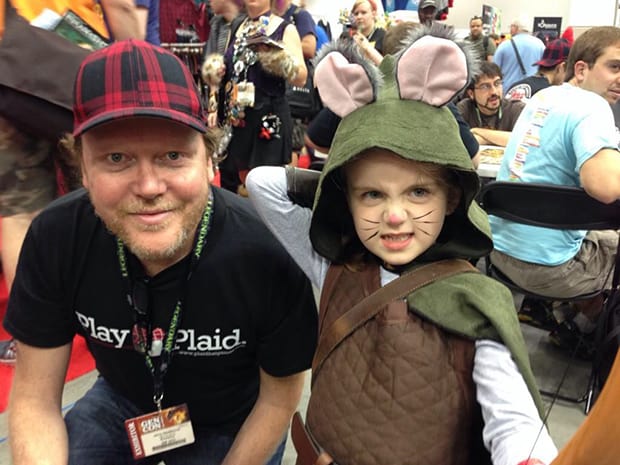
Game making is the ultimate co-op adventure. What can Jerry Hawthorne, Ignacy Trzewiczek, and Mike Selinker tell us about co-op design? Let’s find out!
—
1. WHAT CHALLENGES DOES CO-OPERATIVE GAME DESIGN PRESENT THAT AREN’T PRESENT IN OTHER DESIGNS?
I think the most obvious challenge is to create dynamic artificial tension that is more than just a puzzle being solved by a group. While it seems straight forward at first glance, once you start designing the actual mechanisms that deliver this experience, time limitations, rule density, and the resulting streamlining will conspire against your design goals, possibly turning the experience back into a predictable puzzle. I think one way to fight this is through variety of experiences generated by the game components/content. When there are a plethora of diverse interacting challenges for the players to overcome, the predictability is diminished.
Well known Alpha Player problem is a huge problem. Right balance of difficulty level is another problem. Designing the game as if it actually reacts to players actions is another. There is many issues that have to be solved. In most cases they are not solved. We, designers have work to do, we have to find better solutions. I see great potential in cooperative games and I believe they will be better and better in following years. In my opinion at this point theres is still too many cooperative games that struggles with mentioned problems.
There is a thing called the “Pandemic problem,” except it didn’t originate with Pandemic and it isn’t always a problem in Pandemic. But nonetheless: Sometimes one player wants to run the game for everyone. A good co-op design knows this is a possibility and figures out something that gets in the way of that.
2. HOW DID YOU DESIGN IN-GAME PROBLEMS THAT CHALLENGE PLAYERS WITHOUT BEING ROUTINE OR OVERLY MECHANICAL?
I have only designed 1 co-op system, so keep that in mind, and opinions about my design choices abound. My attempt was to create an all-ages, story that people could cooperatively experience and interact with. The story itself is mostly on rails, but the adventure along the way can be vastly different due to converging random elements that have been balanced and tested to throw challenges at the players. These require cooperation to effectively overcome. I think of these as subsystems. With a finite amount of adversaries, and necessarily straight forward enemy AI, combat can become predictable. To minimize this we try to add variety of enemies, each with abilities designed to break up routine hero strategies. A wide choice of heroes and equipment, plus pre-scripted special encounters help as well.
I added so many cards, events, items, beasts… There is cheap way to escape from routine, but it worked
I believe randomness kills routine. I believe that nothing kills more efficiently this ‘I am eurogamer, I calculated all odds and I know what we should do now’ than few dice. I strongly believe that well designed, smart engines of random factor can kill routine, can spice up the game, can bring emotions.
I love dice. As long as they are put into box along with a smart rules.
It’s tough, but you have to try. Co-op games are often played by the same group doing the same things, so the players demand more variety from the game. That’s what makes some co-op games last a long time: different victory conditions, different headaches, different resources. Always different.
3. DO YOU DESIGN WITH A SPECIFICALLY DIFFICULTY LEVEL IN MIND? HOW OFTEN DO YOU WANT A GROUP TO WIN THEIR FIRST PLAY OF YOUR GAMES?
My design goals are affected by the fact that a story is involved. The story is broken up into chapters. Each chapter represents a game session and advances the plot of the book. I shoot for a 70% win rate because I don’t want my players to have to play through a chapter too many times to beat it. I also include mechanisms that help a group lose quickly as it reveals less of the story, and allows them time to try again. This is accomplished by the chapter end getting pushed back through achievements.
I want cooperative game to be hard, to be challenging, to be something I want to beat finally. Of course, at the same time, it can’t be ridicolously difficult. At some point, if I see, there is no way to win, I’d just stop playing it. For Robinson Crusoe your first game will be more likely quick death. You learn that weather is danger. Your second game will be more focused on building strong shelter. You will die again because of wild animals or lack of food, but you will learn something. Next game you will be ok with weather and food, and the only problem will be lack of wood. Finally, your 4th or 5th game will be a win. And that will be an amazing feeling. You learned how to win, you were improving over and over, you learned how to deal with danger that is hidden on the island.
Then you play second scenario. And you learn right from the scratch.
I like it, I am proud of it, I think it is good way yo put dificulty level into game. It is bloody hard, but you can slowly learn how to deal with these problems and you have tools to win.
Oh, it depends. When we designed Pathfinder Adventure Card Game, I asked my developer Chad how often a party playing the Pathfinder RPG loses a quest. “Basically never,” he said. So we knew our answer couldn’t be that. But it also couldn’t be crazy different from that, or it wouldn’t be Pathfinder. Now, Apocrypha…
4. WHAT CHALLENGES DID YOU FACE IN BALANCING A COOPERATIVE GOAL WITH INDIVIDUAL AUTONOMY FOR PLAYERS?
If players become too autonomous, they will never reach their goal. To keep the players on track, I apply a timer pressure and confine the action to a given area. Rarely are players able to wander off. The underlying premise is that fragile creatures need to learn to trust and depend on one another for survival. I’ve read about the alpha player problems that some people gripe about with co-ops, but I have honestly never seen it. The main thing I have done is give each character a unique set of skills that contribute to the goal in differing ways. If you play a chapter multiple times with different characters, you will have a different experience each time. Amusement is derived from watching a friend play his chosen character’s strengths and each player gets a chance to shine and add value to the endeavor.
That’s a huge problem. Alpha player problem, needs of every player to have active part in the game, to have something meaningful to do, and at the same time create this team work feeling, this team effort, this team based goal. I wouldn’t say I designed perfect set of rules to achieve this, I wouldn’t say that each of the players have super interesting part of the game and at the same time he builds something that will help achieve main goal.
I give you example.
We have a soldier in Robinson Crusoe game. On one hand you’d design this character the way he is super good at fighting and fighting. That way you design a character that helps team gather food, he hunts, he brings food. Cool, right?
It’s not that cool, if you look at this in an actual game play. The game takes 8 rounds and in each of this round this player goes hunting. He spends 2 hours of his life just sending his worker pieces on a Hunting action. Boring.
So it is hard to create interesting task for players, task that will make thematic sense, task that will move everybody towards team goal and at the same time task that are variable, different in each round, interesting for players.
Final version of the Robinson gives players characters who have some abilities to help them act in a thematic way, but at the same time, don’t determine what they will do in each round.
I belive future will bring us better solutions.
I might even have one in mind
I solve the Pandemic problem by encouraging self-interest. In Betrayal at House on the Hill, anyone could be randomly selected as the traitor; thus playing fulling cooperatively means you might load your traitor up with things he can use to kill you. In Pathfinder, you care about the contents of your deck over the long haul; thus, letting someone tell you to give them the Sword of Awesome means you don’t get the Sword of Awesome.
5. WHAT ADVICE DO YOU HAVE FOR DESIGNERS ATTEMPTING THEIR FIRST COOPERATIVE DESIGN?
Make cooperation an essential requirement for success. Understand that cooperation will need to be realized between players of different genders, ages, gaming experience, preferences. Inclusivity is an important ingredient in a co-op. Create mechanics that help resolve or prevent conflict between players. Encourage group decisions with supportive text in the rulebook. Remember that group decision making is time consuming, so keep you subsystems quick, simple and easy to remember. Create opportunities for each player to have a few moments of glory. Create tension that is greater than any one player can manage. Create subsystems that encourage players to interact with each other even when it’s not their turn.
Play as many cooperative games as you can. I played so so so many of them before I began to work on Robinson Crusoe.
Find problems in these games.
Name them, analyse them, think about them.
Solve them.
Find new ideas, find ways to make coop games genre better.
Than start designing.
When people play a co-op game, they are looking for a challenge. You can’t hold their hand. Let them sink or fail on their own. But when they fail, give them reasons to get back up and say, “We can totally take that. Let’s go again.”








